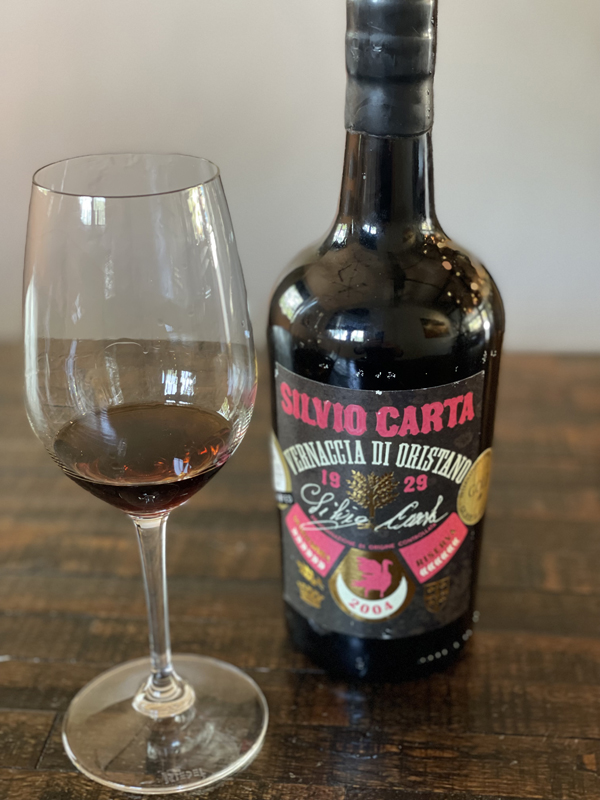2004 Silvio Carta, Vernaccia di Oristano DOC Riserva, Sardinia, Italy.
A rare treat and a wine almost never seen outside of the Oristano region on the island of Sardinia, the traditional Vernaccia di Oristano, which has the aromas, flavors, and structure that remind some of a quality version of Amontillado sherry, though this 2004 Silvio Carta has the exotic and sweeter personality of Pedro Ximenez, though not as sweet and or an aged Marsala, with the color of motor oil and a round palate of fig, apple sauce, walnut, orange rind, dried apricot and tropical essences, as well as having an oxidative core, with light earthy tones and savory nuttiness. This was the first real experience with a classic vintage Vernaccia di Oristano DOC and while not an everyday wine, I was very much impressed with this fascinating offering by the legenday Silvio Carta winery, founded in 1929, an estate well known for their historic and traditional examples, it is a wine that goes great with a variety of desserts and or as an after dinner sipper with a hard cheese plate, though locally it also goes with Bottarga, the dried and cured fish roe delicacy of Sardinia. The Vernaccia di Oristano grape is one of many varietals to be called Vernaccia, but is unrelated any others found in Italy and it is certainly not to be confused with Vernaccia di San Gimignano, the crisp and light Tuscan white wine. The Sardinians have an ancient, traditional and unique method for tapping these Vernaccia di Oristano barrels, done to not disturb the flor atop (inside the cask) of the wine, which is called spiseddadura, where they cut a hole in the lower part of the barrel to extract wine and after they plug it with hemp. These Vernaccia di Oristano wines can be multi vintage blends, but this one is all from a single harvest and is vintage labeled and saw some passito fruit (riper picks) and comes in at closer to 16% natural alcohol.
Originally established in 1971, Vernaccia di Oristano was the first D.O.C. established in Sardinia to promote this white grape, who origins are somewhat murky, with locals claiming it is native to their island, while most believe it came with the Phoenicians in ancient times, maybe coming from Greece. In order for a wine to bear this D.O.C. on the label, the wine must be made from 100% Vernaccia di Oristano and must be grown and made within the municipalities of the lower Tirso subregion, near the sleepy seaside village of Oristano itself. The rules say maximum vineyard yields are set at 80 quintals per hectare and there is a 15% minimum alcohol requirement under this D.O.C. The wines can be both sweet and or dry in style. There is a two-year minimum aging period in barrels and the Superiore designation requires a minimum alcohol level of 15.5% and a minimum of three years barrel aging, while the Riserva designation, as in this wine, goes a step further with a four-year minimum barrel aging requirement. Like Sherry wines, Vernaccia di Oristano is aged under flor and unlike Sherry it is rare that wines are fortified with spirit and sees locally made chestnut barrels, usually close to a hundred years old, employed here. The Flor forms a biofilm on the wine’s surface, and during years of aging, the wine undergoes a gradual oxidation under this protective layer, making for the mentioned oxidative characteristics, with nutty, savory, or umami aromas and flavors. As noted, mainly chestnut wood is traditionally used during the maturing period, though oak can be used if desired, and are filled to about 90 percent capacity, leaving some headspace for oxygen that the Flor yeast needs. These wines are complex, not overtly sweet and reward the adventurous, I enjoyed this Silvio Carta Riserva version a lot and hope to try it again!
($40 Est.) 93 Points, grapelive
